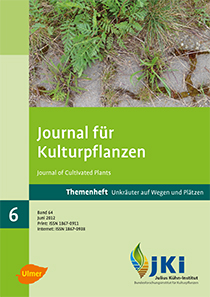Weeds on hard surfaces in Saxony and efficacy of thermic weed control
DOI:
https://doi.org/10.5073/JfK.2012.06.06Keywords:
Weeds, hard surfaces, footpaths, places, thermic weed control, hot foam, hot water, hot steamAbstract
During the years 2006 to 2008 a research of weed occurence on footpaths and places was carried out in the city of Chemnitz and in the surrounding area. More than 70 weed species were found. Dominant species were Poa annua L. and Taraxacum officinale Wiggers. They were found on more than 90 of the places. Mosses and Plantago major L. occurred on about 80% of the locations. Solidago canadensis L., an invasive species, was found on almost 70% of the places.
Poa annua had the highest average weed cover. Mosses and Taraxacum officinale had also a high weed cover.
During the time span from 2006 to 2010 a research of the efficacy of thermic weed control systems was carried out in the city of Chemnitz. The following systems were tested:
1.Hot foam system „Waipuna“ in 2006 and 2007, altogether 9 areas, 2 applications per year;
2.Hot steam system „OMK“ in 2008, 11 areas, 3 to 4 applications per year;
3.Hot water – hot steam system „Geysir“, in 2009 and 2010, altogether 10 areas, 3 to 4 applications per year.
These three systems had mostly good efficacy against annual weeds and mosses. They failed to control Taraxacum officinale.
None of the three systems provided a complete weed control with the above-mentioned number of applications. Weed cover was reduced by perennial application of the hot steam – hot water system „Geysir“.
Downloads
Published
Issue
Section
License
The content of the journal is licensed under the Creative Commons Attribution 4.0 License. Any user is free to share and adapt (remix, transform, build upon) the content as long as the original publication is attributed (authors, title, year, journal, issue, pages).
The copyright of the published work remains with the authors. The authors grant the Journal of Cultivated Plants, the Julius Kühn-Institut and the OpenAgrar repository the non-exclusive right to distribute and exploit the work.







